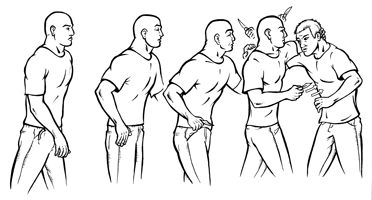Hank Reinhardt's Book of Knives: A Practical and Illustrated Guide to Knife Fighting (12 page)
Read Hank Reinhardt's Book of Knives: A Practical and Illustrated Guide to Knife Fighting Online
Authors: Hank Reinhardt

WHIT WILLIAMS
There are people whose abilities defy what we believe to be human. Vagueness is the fault of history and thus the feats of Milo of Croton, Egil Skallagrimsson, and the like are lost to legend. Fortunately modern history included the camera and similar technology able to prove that there are supermen and that they still walk among us. We have Bob Munden’s uncanny fast draw, Howard Hill’s uncanny archery, and Roger Bannister’s perfect mile to name a few. I believe Hank was one of those men. He could throw an ax as accurately as most shoot a pistol. In his sixties he regularly worked out and sparred with men a third his age. But his most remarkable attribute was simply his speed.
Hank’s speed had been officially tested twice in his life, once at a driving school and again by an efficiency expert. In the latter test he was found second to only Babe Ruth. In the former, his reaction time was deemed impossible. The tester actually thought his machine was broken until Hank repeated the demonstration. It had been tested in real life as well, like when he slipped under a right cross and delivered six rib breaking punches before his opponent could recover. Or another time when a pair of roughs intent on road rage pulled up loudly beside him. Hank ignored the taunts, but when he saw doors opening he knew trouble was coming. His would-be assailants never left the vehicle however. Hank exited his vehicle in a flash and slammed the door on the shin of the exiting passenger. One quick punch dispatched that one and then Hank leapt into the backseat of the convertible and dispatched the other similarly.
Speed had saved Hank’s life as well. In his youth Hank hit a patch of gravel in his car once, spun out, and headed over a steep embankment. The resulting crash crushed dash to seat and surely the life out of the driver as well. Only the driver wasn’t there. Somewhere in that awful descent Hank had leapt into the backseat escaping injury. Years later, while driving through Atlanta, Hank was T-boned at an intersection, the intrusion surely maiming or even killing the driver. Once again Hank wasn’t there. Instead, he was sitting unscathed in the very surprised lap of his friend and passenger Sam. In a nearly identical incident, Hank’s daughter was driving and was equally surprised to find herself safely in Daddy’s lap having been pulled from danger by hands so fast that she didn’t realize it was happening.
It is tempting to chalk these exploits up to luck and genetics, and Hank would agree that both played a role, which brings to question how any of it could be learned. Experience, however, proved to me that there was more involved.
It was five or so years into our friendship when I was driving home one night and had a disagreement as to the right of way. As I was on a motorcycle, and they in a SUV, I wisely altered course. Unfortunately my new direction was toward a guard rail and beyond that a precipice not unlike the one Hank had faced. I tried to steer out of it but my tires hit the curb at an angle, dumping bike and rider hard to the pavement—only the rider wasn’t there. Instead I was standing safely by looking down at the damage. You see I had jumped off the bike. This wasn’t a planned action, in my wildest dreams this solution to a crash had not occurred to me. Nor was it lucky panic. I saw what was happening, consciously let go of the handlebars, placed both hands on the gas tank, did a big push up off the bike and hit the ground running. I couldn’t help but see the comparison with Hank’s experience.
There were other signs as well. I am famously clumsy and am known for dropping fragile things and knocking over beer bottles with gestures of my right hand. I am also known for catching them before they hit floor or bar. The thing about this is that I am not particularly fast. In fact I am probably the slow man on the fight team. Some of my other opponents beg to differ, but the camera doesn’t lie, and I demonstrate no remarkable velocity in movement. No, it isn’t the speed of my movement; it’s the learned lack of wasted effort.
Hank was an avid reader and possessed a collection of all things martial that rivaled any common library or bookstore. Despite that there was only one book that Hank credited with directly affecting his fighting style. Not the well worn copy of
The Book of Five Rings
, nor the well loved sagas of Iceland, it was the novel
Cheaper by the Dozen
. Now, if you’ve read this good work you should realize that it was not the Gilbreth’s fertility that was of interest, but their professions. They were pioneer efficiency experts and liked to measure tasks in therbligs. A therblig is a single motion and the fewer therbligs used the more efficiently the task was performed. Well, sparring Hank was a study in minimalism and efficiency. When you cut at Hank he did not dodge, he did not parry, he simply wasn’t where you thought he was. And on the opposite end there was no wind up, no tell of motion; hell, there was rarely any motion perceived, just the sting of a rubber knife on your hand or the sound of it bouncing off your fencing mask.
Not long under this tutelage I became aware of how slow the rest of the world seemed to move. Like one of the many times a patient came up off of the stretcher swinging. This particular patient was in good shape for having been on the losing end of a knife fight. He was fortunate to have only minor wounds but was covered in blood and high on adrenaline. My fellow EMT was the real speed demon that day, having uttered the offense that aroused our offender and then promptly exited the ambulance faster than I had ever seen him move. In the meantime that bloody fist seemed to take forever in its course, and when it finally got there I wasn’t. I let it pass me by and then grabbed the offending shoulder and continued its owner’s motion around and out the side door. My philosophy here was that he would either realize he needed my help or bleed out enough to become manageable, either way I could wait him out. As it turned out Atlanta’s finest had just arrived and I had thrown him into the arms of a large officer who promptly threw him back at me. A couple of rounds of ping pong later and the patient became manageable. I looked out to see what had become of my partner and spotted him across the street far enough away to be calling for the back-up that had already arrived.
Stories about the mean streets of Atlanta were something Hank and I shared, he having lived in them, me working them. But there were far more insidious things in them to worry about than fists. I was placing EKG leads on a patient sitting on his front porch when someone down the street decided they had a score to settle with him or his friends, or possibly just had a pathological dislike for medics. In any case when the shooting started I am proud to say I was the first behind cover. But it didn’t seem that way at the time. I remember looking up at the noise and distinctly noticing that there were at least two guns involved, one with the high pitch of a small caliber rifle and the other the low thump of a large caliber pistol. Then I noticed pieces flying off the porch around me and a peculiar sensation of hot tingling on my face which I can only describe as the sensation of awareness of vulnerability. It then occurred to me that perhaps I should get behind something and I stepped into the open door of the house. Meanwhile my partner hit the ground hard enough to injure himself and the patient experienced a remarkable recovery and fled the scene. Two things I learned that day was that Churchill was right and that time really does slow down. Only it wasn’t the way I had read about it. There was no tunnel vision, there was no panicky motion, I had all the time in the world and used it wisely.
About a year later, and half a world away in Baghdad, a rocket came screaming past my clinic one day (rockets, by the way, are loud and terrifying in a way you just have to experience to understand, but it’s mortars that keep you up at night for the opposite reason in that they don’t have that polite warning of direction) and in one smooth motion I was under my desk, pistol and vest in hand.
Just south of this in a slightly friendlier neighborhood I had been attacked by a group of disgruntled locals. I had a lucrative position at the time and feared deportation so I refrained from delivering an immediate pummeling and went on the defensive. Easily avoiding both fist and foot and whipping agal (the fan belt that accessorizes Arab headgear), I kept my eyes on hands and waist looking for the danger: the dreaded jambiya and the Middle Eastern tactic Hank had taught me to watch for. This was a grab of the shoulder, a knee to the groin and finally a knife to the throat. Neither materialized and I quickly realized I had little to fear from this assault. They apparently got that point as well and gave up, freely going on their way through a country that rarely prosecutes offenses to foreigners.
Hank was glad to have me back Stateside but I was sad to see that in his seventies youth and skill might finally catch old age and treachery. We last sparred about a month before he went into the hospital. We paired off with rubber knives in his basement and in one explosive move I reached out and cut his right hand. But before I could congratulate myself I received a cut across my throat from right to left. Right to left! Yes, I had cut his knife hand—but the knife was no longer there. Hank had treacherously swapped it to his left hand and I never saw it coming.
PART II
Greg Phillips
FOREWORD
I have been interested in edged weapons, and edged weapons combat, for as long as I can remember. Fortunately for me as a young boy, Hank Reinhardt moved into the apartment next to mine. Hank liked to tell the tale of how he first met me—that I was squatting in the brush next to a fire with one unknown piece of meat on a spit, flaking a stone point.
And in Hank’s book of short stories that he and Jerry Page put together,
Heroic Fantasy,
he wrote, “And I gave him the gift of steel.” Actually this is a great exaggeration but still not far from the truth. This was back in the day when if you wanted a shirt of mail you damn well had to make it yourself. This project and others put me on a long and interesting path learning the history of how weapons were made and used.
This book is a history of knife combat. As in all such histories, there are some graphic details in this book. This is a book about how it was. Not a how-to book. Neither Hank nor I are suggesting that you cut your hair into a duck tail, put on too-tight blue jeans, buy a vintage Springer switchblade, and start searching your local alleys and bars looking for a rumble. But there are lessons to be learned here. What Hank taught me was, “The best fight you will ever have is the one you never get into.”
In all histories of warfare there are many distasteful scenes and descriptions. If this book were about the atom bomb and the horror of its use at Hiroshima, I wouldn’t suggest that you build a bomb and blow up a major city to see how it works. Nor are we suggesting here that you use the information in this book to engage in grisly knife combat. I hope you enjoy this work of history as much as I have enjoyed being able to put it all together.
—Greg Phillips,
Birmingham, Alabama, 2011
7
CHOOSING A KNIFE
Knife design has advanced considerably since Hank Reinhardt practiced it in the 1950s to 1970s. I first became aware of this as a teenager, when I saw Hank flip open a knife one-handed, a stunning feat in those days.
Is this a switchblade, I asked him? He introduced me to the lock-blade knife and showed how the trick was done. Nowadays this is no big deal, with companies manufacturing knives with blade assists like buttons and loops. With almost no practice you can equal the speed I achieved as a teenager—and with no cut thumbs either.

Mercator, one-handed operation thumb groove. 7¾ inches overall length.
From the collection of Greg Phillips.
When I was a kid, one of the ways to modify a pocket knife to speed one-hand opening, was to stick a bolster—a matchstick, or two toothpicks—in the handle of the knife to partially raise the blade and make opening easier.

Al-Mar folder, 7 inches overall length.
Photo by Oleg Volk. HRC648
The knife would be bolster-down in your pocket, and in theory you would grab that knife and the point would snag on your blue jeans as you drew it, and you would impress all with this lightning-fast one-handed opening. The first time I ever saw this done, I really didn’t think it was that good a trick, and years later I can tell you the major disadvantage of opening this way.
I was sitting on a loading dock with a number of my coworkers, and I had to cut the plastic band off a box. I pulled out my knife and opened it one-handed, which was kind of a surprise to some of the guys. At the time, this was not the kind of thing that a clean-cut boy was supposed to be able to do. Immediately one of my coworkers said he was a lot faster using his method of opening as opposed to mine. He had a yellow handled Case pocket knife and had bumped the blade up with two matchsticks. I returned my knife to my pocket and told him to “beat this.” Now we had a crowd, and with a crowd comes some pressure. With a certain element you just “ain’t no man unless you can get your knife out.”
We had a foreman say “go!” He went for his knife and I went for mine. I hate to admit, but he did time me dead even. I looked over at his face and I saw a look of surprise. I then realized that it was not the surprise of tying me on a knife-drawing contest, but the fact that on the draw he had managed to cut a two-inch-deep, four-inch-wide gash across his ass.
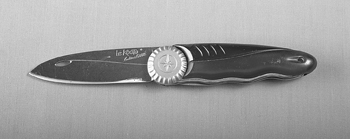
Circular mechanical assist, 7½ inches overall length.
HRC629
ASSISTED OPENING TECHNIQUES
These days, there are basically four ways to open a knife one-handed. We have the Spyderco thumbhole system;
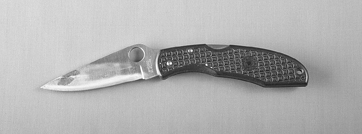
Spyderco, 8½ inches overall length.
HRC250
the thumb stud and levers at the top of the blade; assisted opening; and switchblades or automatics. Let’s get the switchblade subject out of the way. There are several current manufacturers of switchblades. Some are quite good, but the one thing they all have in common is that they are mechanical. The most important thing about a weapon is reliability. Anything that uses a spring to make it open, whether it be a flat spring, or a coil, or a cold spring, can break, or get clogged with pocket junk. This means it won’t open when you need it the most.
On top of that, the only switchblades I’ve seen with any speed are those with coil springs. The rest are slow and noisy. As Hank pointed out earlier, sometimes it is best to open your pocket knife quietly. It’s best for your opponent not to see or hear it. This isn’t possible with a switchblade. They are either opening loudly with a great deal of speed, or not at all.
The best thing to do is to keep it simple. There are just better choices for a pocket knife than automatics.
Now let’s talk about assisted opens. You might call this a geriatric switchblade. It opens quickly but you have to help it. This is the worst of both worlds. The only advantage I can see here is one of legality. It isn’t an illegal switchblade, but then in its action it almost is—but on the other hand it might keep you out of the slammer.
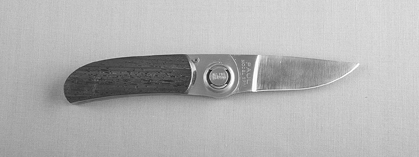
Precursor to assisted opening knife with button lock, circa 1980, 7 inches overall length.
From the collection of Patrick Gibbs.
Next, we have thumb studs:
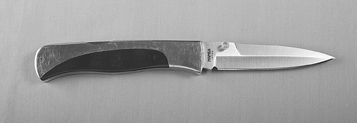
Knife with thumb stud, 9¼ inches overall length.
HRC621
this is probably your second best way of one-handed opening, but it still lags far behind the Spyderco hole. There seems to be a new gadget coming out every day for opening a pocket knife one-handed. By the time this book is printed, who knows what new inventions we will see. But keep these things in mind—the most important advantage of any knife, or for that matter any weapon, is that it must be simple and reliable. This is especially true when someone is under stress. So ask yourself: how well will any new design perform if your hands are cold, wet or injured? How quickly and well can you get this knife into operation?
At this time, I think the best thing out there is a Spyderco with the wave feature.

Spyderco Wave, 7 inches overall length.
From the collection of Greg Phillips. Photo by Oleg Volk.
As you draw the knife from your pocket, this small hook grabs the cloth of your pocket and snaps the knife open. You can do this with cold hands, wet hands, and arthritic hands. At this point I think this is the best and fastest pocket knife on the market.
Who would have ever thought that the hole in the top of a blade, a simple yet ingenious design, would change the knife world as we know it? This was the first attempt to design a knife that would open one-handed that everybody could use. Once this trend started it launched a tidal wave of gadgets for opening blades one-handed, some good and some not so good.
CLIPS
While we are on the subject of fast operation, let’s talk about pocket clips. The big advantage of clips is that you always know where your knife is in your pocket. This helps make for a fast and smooth draw. Also, with your pocket clip, you need to be able to move the clip from one side of the knife to the other. For all you left-handed guys, when you look at your knife, make sure that you can move the clip to left or right side, and from top to bottom. This is a tremendous advantage if you carry a gun on your right side, you can still have your knife available for a left-handed draw.
Now for the disadvantages: All you have to do is look at somebody’s pocket and you can see a knife clip there. There are many times when you don’t want anyone to know you have the knife on you. That’s why you need to have a pocket clip which is removable. With a removable clip, you can have a deep concealment draw of your knife. You don’t want anything to snag the blade in your pocket. For the deep draw you need to take the clip off.
Spyderco was the company that introduced the pocket clip. This small little strip of steel now means that your pocket knife is always in the same position and you don’t have to either dig through the change and other pocket detritus to find your knife or sew your pockets, as Hank suggested.
